Pipe Obstructions: Investigation, Prevention, and Solutions
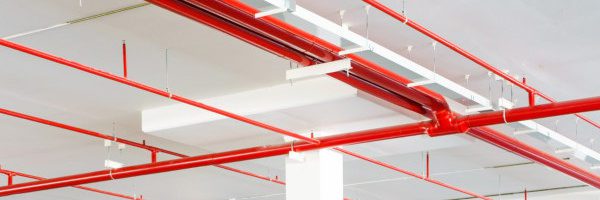
Helping property owners and contractors understand the importance of investigating and preventing pipe obstructions in fire sprinkler systems
Fire sprinkler pipes maintain the ultimate poker face. Without a proactive approach to preventing obstructions, a system could be masking issues deep within its pipes that sabotage the ability to flow water.
With common pipe diameters as small as 1” and sprinkler orifices as small as 3/8” in commercial systems, it doesn’t take a great deal of blockage to inhibit water flow. But since visible signs of obstructions are uncommon, it can be hard to convince property owners that a deeper look into pipe is necessary.
When specific conditions or routine assessments raise red flags about corrosion, debris, or other potential blockages, obstruction investigations are critical to ensuring that sprinkler pipes won’t fail to deliver water.
NFPA 25 sprinkler obstruction assessments and investigations
At a minimum, the 2020 edition of NFPA 25: Standard for the Inspection, Testing, and Maintenance of Water-Based Fire Protection Systems (14.2.1.1) stipulates “an assessment of the internal condition of piping” every five years to inspect for the presence of corrosion and foreign materials that could prevent sprinklers from functioning.
If a sufficient volume or type of corrosion or material is discovered, NFPA 25 requires a more in-depth look at pipe conditions through an obstruction investigation (14.2.1.4). Obstruction investigations are more extensive than routine assessments and don’t have a specified frequency. They are triggered by specific events or conditions occurring within a sprinkler system or its water supply infrastructure.
Due to their higher propensity for corrosion, pipes in dry and preaction systems are checked for clogs every three years during the full-flow trip test required by NFPA 25 (13.4.5.2.2.2). Traces of water left to pool in normally dry pipes after testing or activation make these systems more susceptible to corrosion, which is a major source of blockages.
Non-metallic pipes like CPVC that are corrosion-resistant are exempt from NFPA recommendations regarding the frequency of pipe inspections (14.2.1.5). However, it’s important to note that even this type of pipe can suffer clogs and requires a strategy for detecting them.
The standard recognizes that a significant amount of time stretches between routine pipe assessments. And since pipes rarely give obvious clues that they are blocked, they can easily hide issues that could lead to failures. For that reason, NFPA 25 (14.3.1) outlines specific conditions associated with pipe blockages that should trigger an obstruction investigation, even outside of routine testing. Knowledge of a system’s specific environment and usage history is important to assess the risk adequately.
The 15 conditions that should always raise red flags include:
- Defective intake for fire pumps
- Discharge of foreign material during water tests
- Foreign material in fire pumps, dry pipe valves, or check valves
- Foreign material in water during drain tests or plugging of inspector’s test connections
- Unknown material heard in system piping
- Plugged sprinklers
- An excessive volume of foreign material in pipes
- Failure to flush yard piping or surround public mains following new installation or repairs
- A record of broken public mains in the vicinity
- Abnormally frequent false tripping of dry pipe valves
- A system returned to service after a shutdown greater than one year
- There is reason to suspect sodium silicate or other highly corrosive fluxes in copper systems
- A supply of raw water via the fire department connection
- The presence of pinhole leaks
- A 50% increase in the time it takes water to travel to the inspector’s test connection from the moment a dry pipe valve trips during a full-flow trip test, compared to the original system acceptance test
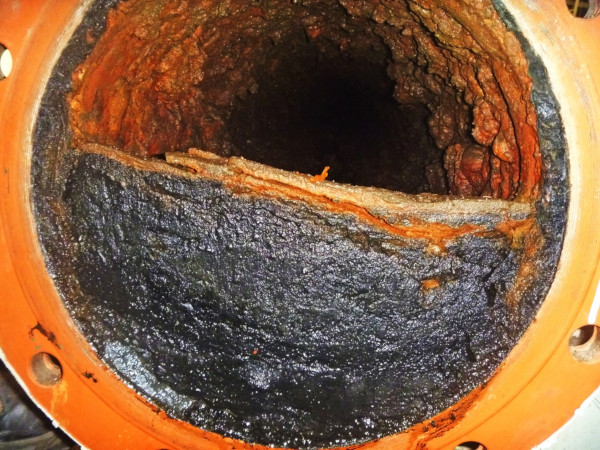
Byproducts of corrosion are a leading source of pipe obstructions.
What causes pipe obstructions in fire sprinkler systems—and how to prevent them
An array of strange objects have been yanked from the depths of sprinkler system pipes, including intact work gloves and odd pieces of trash. But there are some common sources of sprinkler obstructions—and proactive steps that can be taken to prevent them:
Corrosion
Corrosion threatens the reliability of automatic fire sprinklers, and, unfortunately, the presence of water, oxygen, and metal in systems makes it impossible to avoid altogether. Most piping networks contain some evidence of foreign material or corrosion, but not enough to trigger an obstruction investigation.
It often comes down to a judgment call as to whether an initial pipe assessment calls for further investigation. However, significant foreign matter or pipe corrosion is always cause to move on to a thorough and systematic inspection. NFPA 25 (A.14.2.1) recommends that excessive rust, black-colored water, and the smell of sulfur should prompt investigation. The presence of tubercles (“small mounds of corrosion products”) and slime are issues that raise red flags. Slime refers to a microbiological colony of either fungi or bacteria, also known as bio-film.
Salts and metals rapidly collect on the surfaces of pipes with bio-film, forming nodules, tubercles, and carbuncles. Eventually, these buildups can grow large enough to obstruct an entire pipe diameter. They can also loosen during flow and create a blockage downstream. If signs of microbiologically influenced corrosion (MIC) are present, the damage can spread to any part of the network.
Replacing pressurized air with nitrogen in dry sprinkler pipes can help prevent corrosion by removing the presence of oxygen, a critical leg of the corrosion triangle. Dry air generators employing a desiccant-based compressor/air exchanger that dehumidifies the air in the pipe are another option. Considering other materials besides galvanized steel in dry sprinkler pipes can also make a difference. Studies have shown that pinhole leaks may develop in dry systems with galvanized steel pipes within two years of installation, and ruptures can occur within four years—though this depends on the quality control of the galvanization process. The use of nitrogen, a dry air generator, or different pipe material works well in new systems, of course, but does not benefit existing systems that already have leaks, holes, and other issues.
Corrosion monitoring equipment can also catch corrosion at its earliest stages before it leads to obstructions. Air vents can serve as a cost-effective solution for reducing oxygen corrosion in wet sprinkler systems as well, releasing air that would otherwise stay trapped in pipes.
Pipe scale
NFPA 25 (D.2.1) reports that the majority of fire losses attributed to obstructed sprinklers involve dry systems. In those cases, pipe scale is the leading cause of obstruction. Pipe scale is a mineral coating that can form in pipes when water flows through them. When sprinklers open, the scale can break loose and flow down the network, plugging sprinkler heads or causing obstructions at fittings.
System flushing can help keep pipe scale from reaching a problematic level, and public water utilities that soften the water on the supply end may help mitigate this issue. Keeping dry and preaction systems on air (or nitrogen) year-round, instead of alternating gas and water, can also inhibit the formation of rust and scale.
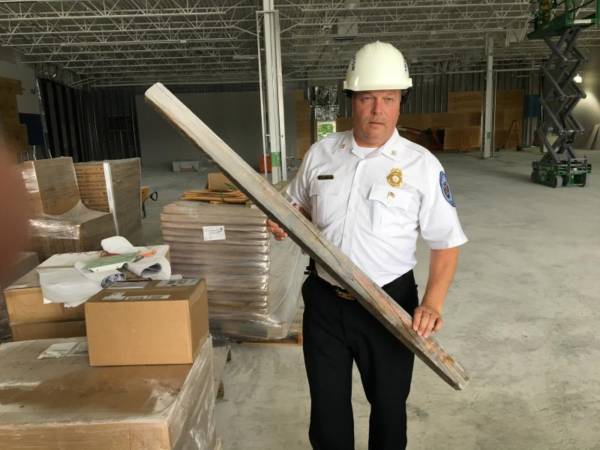
John Lane, division chief of the Anne Arundel Fire Marshal’s Office, found this 2×4 in a sprinkler system during a flush.
Sloppy installation or repair
Careless workers are another significant cause of sprinkler obstructions. Wood, paint brushes, buckets, gravel, sand, gloves, and even painter’s overalls are just a few of the materials that have found their way into pipes, especially when construction or renovation workers mix with sprinkler installers. Another common problem is cutout discs (coupons) left in piping after holes are drilled for quick-connect fittings. Thoroughly inspecting the job site and cautioning all personnel to be careful with equipment around exposed pipe can help address this issue.
Raw water sources
Foreign materials may be suctioned from the bottom of rivers, ponds, or open reservoirs and forced into sprinkler systems by fire pumps with inadequately screened intakes. These obstructions may range from fine, compacted materials like mud or sand to coarser materials like stones, sticks, or wood chips.
Properly maintaining pump suction screens can mitigate obstructions. It’s also worth noting that screens made of copper or brass wire tend to promote less aquatic growth.
Small mill ponds may require periodic dredging to avoid excessive weeds and other growth. Taking measures to prevent material from entering suction piping during the cleaning of tanks and open reservoirs is also essential.
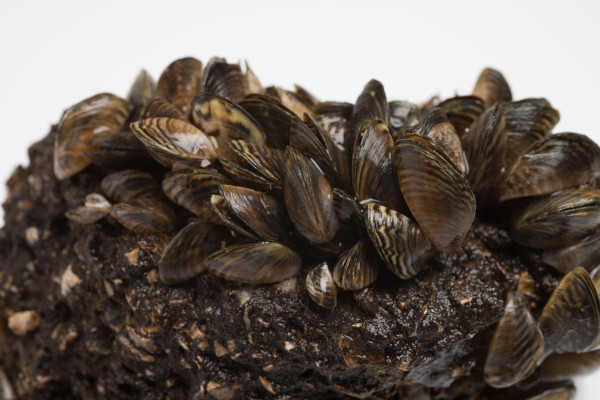
Zebra mussels can infest fire sprinkler pipes supplied by raw water sources, causing obstructions.
Biological growth
Biological growth like Asiatic clams and zebra mussels can clog fire sprinkler systems supplied by raw river or lake water. For instance, the Asiatic clam usually infiltrates systems as small larvae but can grow larger than 2 1∕8 inches (54 mm) by attaching itself to piping and feeding on bacteria or algae that passes by.
Ideally, fire sprinkler systems should be supplied with treated (filtered and chlorinated) municipal water, and not untreated water drawn from an infested water source. But in cases where this isn’t possible, implementing a water treatment program that removes oxygen or adds biocides and/or elevates pH can be effective in controlling zebra mussels.
Molluscicides appear to provide the most effective means of controlling mussel growth in fire protection systems, but many property owners balk at the cost. NFPA 25 notes that chlorination is the best short-term treatment but could cause environmental issues if the water is released into lakes and streams.
Asiatic clams are trickier—to date, NFPA 25 says there’s no practical method for total control. To address obstructions that are hard to prevent, section 14.3.2.1 requires obstruction investigations to be repeated every five years to ensure the pipe will work as expected during a fire.
Calcium carbonate deposits
When the concentration of calcium and magnesium salts is high, water becomes hard. Hard water flowing through pipes made of noble metals like copper can create a thin film composed mainly of calcium carbonate that can offer some protection against corrosion. But unfortunately, the same scale formation also naturally accumulates on sprinklers—and it can plug their orifices, even if the piping is relatively clear.
Calcium carbonate obstructions are most common in sprinkler systems supplied from non-potable wells or surface water in places where water supplies are known to be hard. These blockages can’t be detected or corrected by normal flushing operations. A sampling of sprinklers should be removed and inspected annually in areas where hard water is a problem. Sprinklers with deposits should be replaced, with adjacent sprinklers also examined (D.4.5).
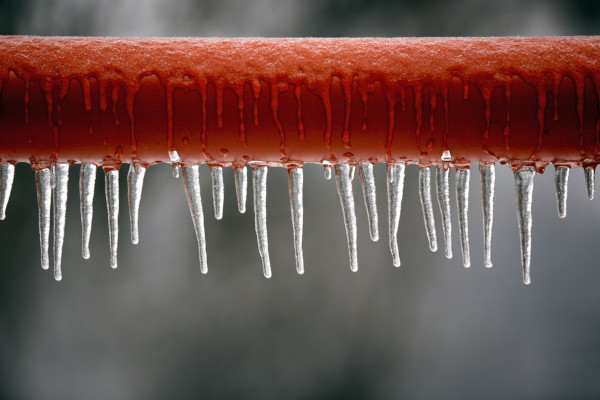
Freezing weather has the potential to cause internal ice blockages.
Ice plugs
When dry or preaction systems pass through refrigerated spaces maintained at temperatures below 32°F (0°C), NFPA 25 (14.4) requires annual internal inspections for ice obstructions. Inspections are conducted at the point where piping enters the refrigerated area. If ice obstructions are found, section 14.4.2 requires the inspection of additional pipe to ensure that no other blockages exist.
If the dew point of supervisory compressed air within dry sprinkler piping is higher than the temperature of the piping or surrounding facility, condensation can occur that leads to ice plugs. Replacing pressurized air with nitrogen can help prevent ice plugs due to the inherently lower dew point of that inert gas.
How to conduct pipe obstruction investigations for fire sprinkler systems
NFPA 25 requires obstruction investigations to determine the extent and severity of an issue when unsatisfactory conditions are observed that could indicate blockages. In Annex D, investigators are advised to check dry systems on a property first since they are the most likely source of trouble.
Carefully selecting several representative systems for testing can generally reveal conditions throughout a property. However, read this carefully: if initial testing shows obstructing material, all systems (if multiple are present; wet and dry), must be investigated to determine appropriate remedies.
Blockages can occur anywhere within a network—and visually inspecting hundreds of feet of pipe would be a daunting task. When determining what to check, obstruction investigators should use a systematic approach that considers which parts of the system are most vulnerable. At a minimum, NFPA 25 (14.3.2.2) recommends investigating valves, risers, cross mains, and branch lines.
Systems can be considered reasonably free of obstructing material if:
- Less than a 1∕2 cup of scale is washed from the cross mains
- Scale fragments are not large enough to plug a sprinkler orifice
- Full, unobstructed flow is obtained from each branch line that is inspected
If other types of foreign material besides scale are found, investigators must judge whether the system can be considered unobstructed. The physical characteristics and source of the foreign material determine the pipe obstruction potential.
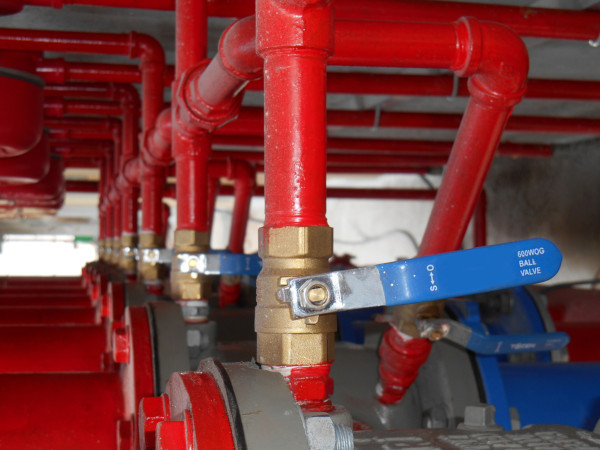
When determining what to inspect, obstruction investigators should use a systematic approach that considers which parts of a sprinkler system are most vulnerable.
NFPA 25 outlines general guidelines for pipe obstruction investigations of dry sprinkler systems. Testing wet systems mimics these guidelines, with a notable exception.
After closing the control valve (item #2 below), wet systems must be drained to enable the installation of hose valves. Once that is done, a tester must slowly reopen the control valve and establish the small hose flow to the branch line, followed by the 2 1∕2 in. (65 mm) hose flow for the cross main. If lines become plugged during testing, piping should be dismantled and cleaned, and the extent of the plugging noted.
NFPA 25’s guidelines for dry systems:
- Flood dry pipe systems one or two days before conducting an investigation to soften pipe scale and deposits.
- After choosing test points, close the main control valve and drain the system.
- Check the piping visually with a flashlight while it is dismantled.
- Attach hose valves and 1 1∕2 in. (40 mm) hose to the ends of lines being tested, shut the valves, restore air pressure on the system, and reopen the control valve.
- Open the hose valve on the end branch line, allowing the system to trip in a simulation of normal action.
- Clear any pipe obstructions from the branch line before proceeding with further tests.
- After flowing the small end line, shut its hose valve and test the feed or cross main by discharging water through a 2 1∕2 in. (65 mm) fire hose, collecting any foreign material in a burlap bag.
- After the test, the dry pipe valve should be cleaned internally and reset. Its control valve should be locked open, and a drain test should be performed.
Alternative methods for investigating pipe obstructions in fire sprinkler systems
Less-disruptive ways of investigating pipe obstructions are also allowed by NFPA 25, such as video and ultrasonic analysis. A qualified professional experienced in these technologies and sprinkler systems should determine which method is best for specific situations.
A push cable with a small video camera and bright lighting can be inserted into valves and risers for a clear look deep inside systems. Some cross and branch mains can also be examined using video devices. Video equipment can be helpful for gauging flushing results as well.
Ultrasonic technology is particularly useful for determining the extent of corrosion, enabling external testing of pipe walls. This method comes with some striking advantages: allowing systems to remain in service during investigations and pinpointing where pipes are likely to fail so preventive action can be taken. It can also detect existing air pockets in wet systems, as well as pipe sections in dry systems that aren’t adequately drained, creating a prime breeding ground for corrosion.
But NFPA 25 (A.14.3.2.3) notes that ultrasonic technology also has limitations. It can detect buildups of sludge and scale but struggles to quantify the severity of a potential pipe obstruction. This equipment can measure the extent of metal loss but can’t determine the type of corrosion responsible for pipe damage. It can also fail to detect the presence of solid materials in piping that aren’t related to corrosion, such as wood or plastic since only small sections of pipe are examined.
Watch this video of an ultrasonic investigation of pipe:
Flushing: the go-to solution for pipe obstructions
In most cases, flushing systems with water (hydraulic method) or air and water (hydropneumatic method) is enough to clear pipe obstructions. Which one is used becomes largely dependent on the source of the blockage.
NFPA 25 (D.5.2) explains that the hydraulic method can generally flush pipe obstructions comprised of loose sand, mud, or moderate amounts of pipe scale. But if the material is hard to remove—or available water pressure is too low for effective scouring action—the stronger hydropneumatic method is preferable. However, note that hydropneumatic flushing can harm listed CPVC sprinkler pipes.
If obstructive material is solidly packed or adheres tightly to the walls of the piping, the pipe will have to be dismantled and cleaned by rodding or similar activity. And if a blockage is extensive, the replacement of pipe or other affected components may be the best option.
It’s also essential to determine the source of the obstructing material to prevent more from entering the pipe. For instance, this could warrant inspection and cleaning of pump suction screening facilities or private reservoirs. If recently laid public mains are the problem, property owners can ask water authorities to flush their systems.
A proactive approach to pipe obstructions keeps water flowing during a fire
An undetected pipe obstruction in a fire sprinkler system can cause total failure in the event of a fire. Taking a proactive approach to blockage prevention can keep sprinkler water flowing in an emergency.
Fire sprinkler ITM professionals should stress the importance of these items to property owners to keep systems working:
- NFPA 25’s 5-year internal inspections of pipe (14.2.1.1)
- The three-year checks on dry and preaction systems (13.4.5.2.2.2)
- Annually assessing a sample of sprinklers where hard water is an issue (D.4.5)
- And the ad hoc investigations that are called for when certain conditions are observed (14.3.1)
Do you have a specific question about pipe obstructions or system flushing? NFSA members can submit a question to our Expert of the Day. One of our most-used members-only benefits, EOD provides informal interpretations of industry codes and standards from NFSA experts within two business days. Not an NFSA member? Join today!
For over a century, the National Fire Sprinkler Association (NFSA) has served as the voice of the fire sprinkler industry. Our mission: advocating to protect lives and property through the widespread acceptance of the fire sprinkler concept. To join NFSA or learn more about the ways membership can benefit your organization, visit nfsa.org/join.
